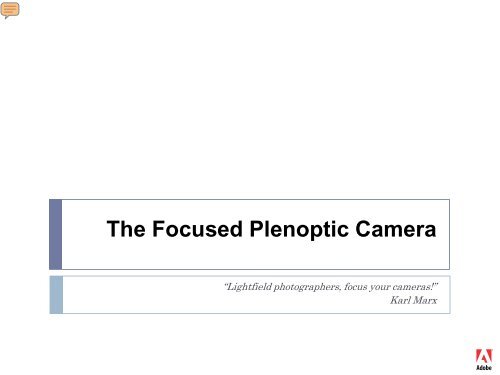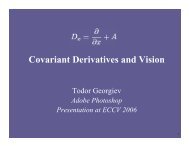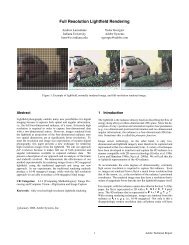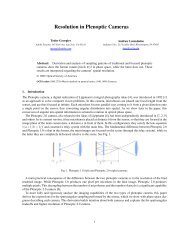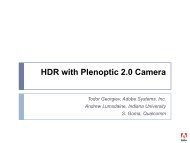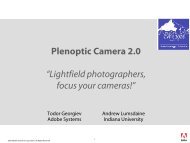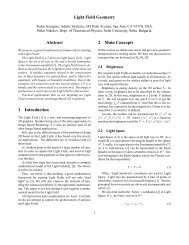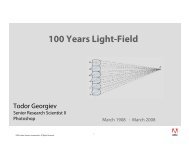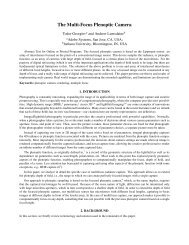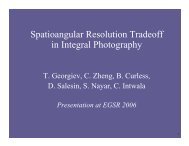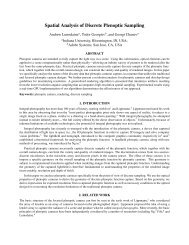The Focused Plenoptic Camera
The Focused Plenoptic Camera
The Focused Plenoptic Camera
Create successful ePaper yourself
Turn your PDF publications into a flip-book with our unique Google optimized e-Paper software.
<strong>The</strong> <strong>Focused</strong> <strong>Plenoptic</strong> <strong>Camera</strong><br />
“Lightfield photographers, focus your cameras!”<br />
Karl Marx
<strong>Plenoptic</strong> <strong>Camera</strong>, Adelson 1992<br />
Main lens focused on microlenses
<strong>Plenoptic</strong> <strong>Camera</strong>, Adelson 1992<br />
Microlenses focused on infinity
<strong>Focused</strong> <strong>Plenoptic</strong> <strong>Camera</strong><br />
Microlenses focused on main lens image
Comparison<br />
<strong>Plenoptic</strong> <strong>Camera</strong> (1.0) <strong>Focused</strong> <strong>Plenoptic</strong> <strong>Camera</strong> (2.0)
Comparison<br />
<br />
<strong>Plenoptic</strong> <strong>Camera</strong><br />
<br />
<strong>Focused</strong> <strong>Plenoptic</strong> <strong>Camera</strong><br />
Microlenses focused at infinity.<br />
Completely defocused relative<br />
to main lens image.<br />
Microlenses satisfy the lens<br />
equation. Exactly focused on<br />
the main lens image.
Comparison<br />
<br />
<strong>Plenoptic</strong> <strong>Camera</strong><br />
<br />
<strong>Focused</strong> <strong>Plenoptic</strong> <strong>Camera</strong><br />
Blurry microimages<br />
Sharp and inverted microimages
Why Inverted?<br />
What is the condition for exact focusing with main<br />
lens image shifted from the plane of microlenses?<br />
Answer: Simple relay imaging! This is like a<br />
telescope with multiple eyepieces.
Lightfield Rendering Small Part of Scene
Full Resolution Rendering: 500X Improvement!
Resolution Analysis<br />
Why do we have so much higher resolution in 2.0?<br />
Because the camera is focused:<br />
<strong>The</strong> main lens creates radiance r(x) at its image plane.<br />
<strong>Plenoptic</strong> 1.0 and 2.0 sample this radiance differently.<br />
For one microcamera, the optical transfer matrix is A.<br />
Radiance on the sensor:<br />
(continue)
Resolution Analysis<br />
For <strong>Plenoptic</strong> 1.0 the transfer matrix is:<br />
Inverse matrix
Resolution Analysis<br />
Rotation of each pixel to 90 degrees in optical phase<br />
space causes the low spatial resolution of 1.0 camera.<br />
For <strong>Plenoptic</strong> 2.0 the transfer matrix is:<br />
Inverse matrix
Resolution analysis<br />
For <strong>Plenoptic</strong> 2.0 <strong>The</strong>re is no rotation, just shear:<br />
Pixels remain “vertical”. b/a of the sensor resolution.
Resolution analysis<br />
<strong>Plenoptic</strong> 1.0 <strong>Plenoptic</strong> 2.0
Two Ways of Focusing<br />
Galilean Telescopic Array<br />
Keplerian Telescopic Array<br />
(Proposed by Galileo and Kepler 400 years ago)
Two Ways of Focusing
Two Ways of Focusing<br />
Gaililean Imaging<br />
Keplerian Imaging
<strong>Plenoptic</strong> 2.0 Refocusing
<strong>Plenoptic</strong> 2.0 Refocusing
<strong>Plenoptic</strong> 2.0 Refocusing
<strong>Plenoptic</strong> 2.0 Resolution<br />
<strong>Plenoptic</strong> 2.0 sampling is more flexible:<br />
Decouples resolution from number of microlenses.<br />
Free to choose the spatial-angular tradeoff point.<br />
We can actually reach very low angular resolution<br />
not possible with traditional plenoptic camera<br />
(because edge effects would introduce noise).<br />
Stereo 3D.<br />
Up to b/a of the sensor resolution can be achieved!<br />
This is up to 100%, i.e. full sensor resolution!
Full Sensor Resolution <strong>Plenoptic</strong> <strong>Camera</strong><br />
Demonstrating image capture with a plenoptic<br />
camera and rendering at full sensor resolution:<br />
39 megapixel capture<br />
39 megapixel rendering
Full Sensor Resolution <strong>Plenoptic</strong> <strong>Camera</strong><br />
Demonstrating image capture with a plenoptic<br />
camera and rendering at full sensor resolution:<br />
39 megapixel capture<br />
39 megapixel rendering
Full Sensor Resolution <strong>Plenoptic</strong> <strong>Camera</strong><br />
Demonstrating image capture with a plenoptic<br />
camera and rendering at full sensor resolution:<br />
39 megapixel capture<br />
39 megapixel rendering
Full Sensor Resolution <strong>Plenoptic</strong> <strong>Camera</strong>
<strong>Plenoptic</strong> HDR <strong>Camera</strong>
HDR with <strong>Plenoptic</strong> <strong>Camera</strong> 2.0<br />
Each point is seen multiple times in different microlenses<br />
We can put different apertures on different microlenses
HDR with <strong>Plenoptic</strong> <strong>Camera</strong> 2.0<br />
We can put different apertures on different microlenses<br />
Fresnel zones<br />
as aperture
HDR with <strong>Plenoptic</strong> <strong>Camera</strong> 2.0<br />
Two of our microlens arrays under the microscope<br />
4 times reduction 8 times reduction<br />
of aperture<br />
of aperture
31<br />
HDR (part of raw image with plenoptic<br />
2.0)
HDR with <strong>Plenoptic</strong> <strong>Camera</strong> 2.0<br />
We can put different filters on different microlenses:<br />
Neutral density, color (for spectral imaging), polarization.<br />
1000 X increase 12-color imaging sampling four<br />
in dynamic range with RGB sensor linear polarizations
<strong>Plenoptic</strong> Superresolution <strong>Camera</strong>
Superresolution with <strong>Plenoptic</strong> <strong>Camera</strong> 2.0<br />
Each microlens is observing the scene as a slightly<br />
shifted camera. We can compute the subpixel shift<br />
based on camera parameters. <strong>The</strong>n, superresolve.
Superresolution with <strong>Plenoptic</strong> <strong>Camera</strong><br />
2.0<br />
37
Superresolution with <strong>Plenoptic</strong> <strong>Camera</strong><br />
2.0<br />
38
Superresolution with <strong>Plenoptic</strong> <strong>Camera</strong><br />
2.0<br />
39
Superresolution with <strong>Plenoptic</strong> <strong>Camera</strong> 2.0<br />
Observe the subpixel shift
Superresolution with <strong>Plenoptic</strong> <strong>Camera</strong> 2.0<br />
Observe the subpixel shift
Superresolution with <strong>Plenoptic</strong> <strong>Camera</strong><br />
2.0<br />
42
Superresolution with <strong>Plenoptic</strong> <strong>Camera</strong><br />
2.0<br />
43
Superresolution with <strong>Plenoptic</strong> <strong>Camera</strong> 2.0<br />
Compare same image with traditional lifgtfield rendering<br />
(plenoptic 1.0).
Superresolution with <strong>Plenoptic</strong> <strong>Camera</strong><br />
2.0<br />
45
Superresolution with <strong>Plenoptic</strong> <strong>Camera</strong><br />
2.0<br />
46


